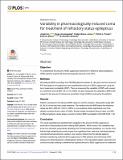Variability in pharmacologically-induced coma for treatment of refractory status epilepticus
Author(s)
Jonnalagadda, Durga; Moura, Valdery; An, Jingzhi; Purdon, Patrick L.; Brown, Emery Neal; Westover, M Brandon; ... Show more Show less
Downloadjournal.pone.0205789.pdf (2.371Mb)
PUBLISHER_CC
Publisher with Creative Commons License
Creative Commons Attribution
Terms of use
Metadata
Show full item recordAbstract
Objective To characterize the amount of EEG suppression achieved in refractory status epilepticus (RSE) patients treated with pharmacologically-induced coma (PIC). Methods We analyzed EEG recordings from 35 RSE patients between 21-84 years-old who received PIC that target burst suppression and quantified the amount of EEG suppression using the burst suppression probability (BSP). Then we measured the variability of BSPs with respect to a reference level of BSP 0.8 ± 0.15. Finally, we also measured the variability of BSPs with respect to the amount of intravenous anesthetic drugs (IVADs) received by the patients. Results Patients remained in the reference BSP range for only 8% (median, interquartile range IQR [0, 29] %) of the total time under treatment. The median time with BSP below the reference range was 84% (IQR [37, 100] %). BSPs in some patients drifted significantly over time despite constant infusion rates of IVADs. Similar weight-normalized infusion rates of IVADs in different patients nearly always resulted in distinct BSPs (probability 0.93 (IQR [0.82, 1.0]). Conclusion This study quantitatively identified high variability in the amount of EEG suppression achieved in clinical practice when treating RSE patients. While some of this variability may arise from clinicians purposefully deviating from clinical practice guidelines, our results show that the high variability also arises in part from significant inter- and intra-individual pharmacokinetic/ pharmacodynamic variation. Our results indicate that the delicate balance between maintaining sufficient EEG suppression in RSE patients and minimizing IVAD exposure in clinical practice is challenging to achieve. This may affect patient outcomes and confound studies seeking to determine an optimal amount of EEG suppression for treatment of RSE. Therefore, our analysis points to the need for developing an alternative paradigm, such as vigilant anesthetic management as happens in operating rooms, or closed-loop anesthesia delivery, for investigating and providing induced-coma therapy to RSE patients.
Date issued
2018-10Department
Institute for Medical Engineering and Science; Harvard University--MIT Division of Health Sciences and Technology; Massachusetts Institute of Technology. Department of Brain and Cognitive Sciences; Massachusetts Institute of Technology. Department of Electrical Engineering and Computer Science; Picower Institute for Learning and MemoryJournal
PLOS ONE
Publisher
Public Library of Science
Citation
An, Jingzhi, Durga Jonnalagadda, Valdery Moura, Patrick L. Purdon, Emery N. Brown, and M. Brandon Westover. “Variability in Pharmacologically-Induced Coma for Treatment of Refractory Status Epilepticus.” Edited by Cecil D Hahn. PLOS ONE 13, no. 10 (October 31, 2018): e0205789.
Version: Final published version
ISSN
1932-6203